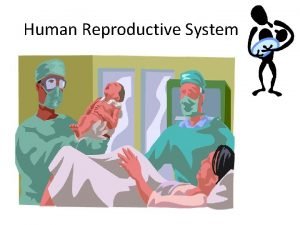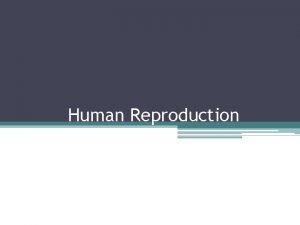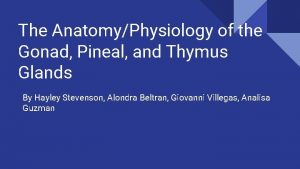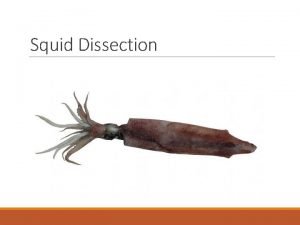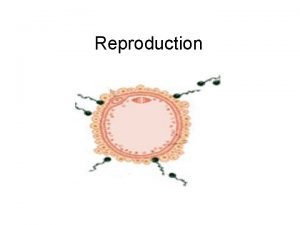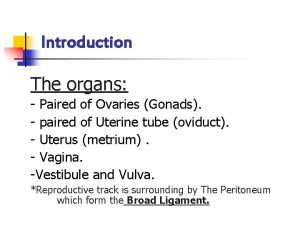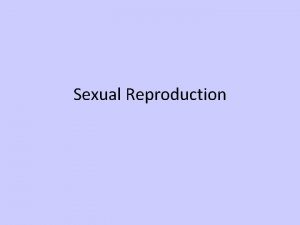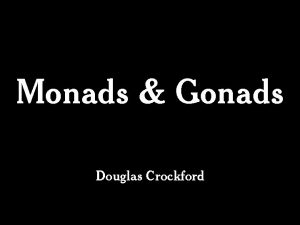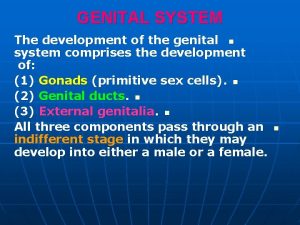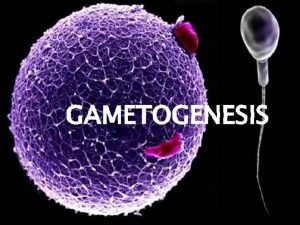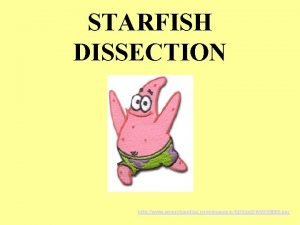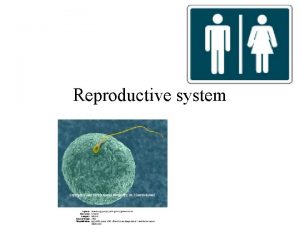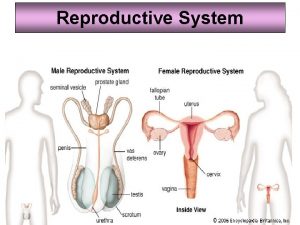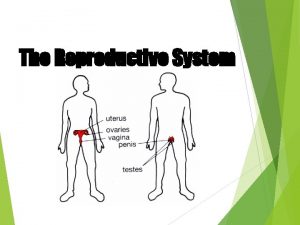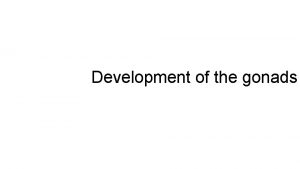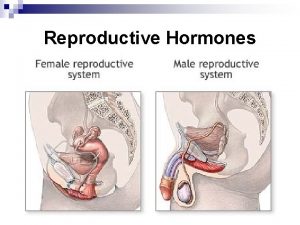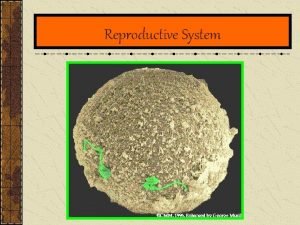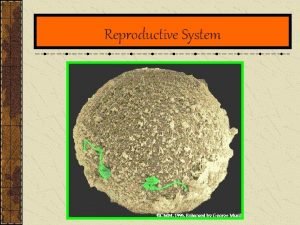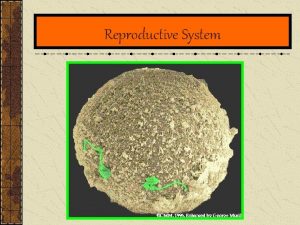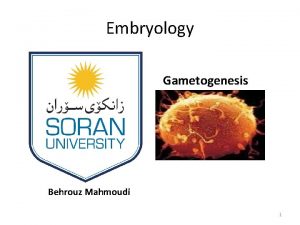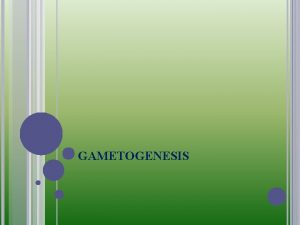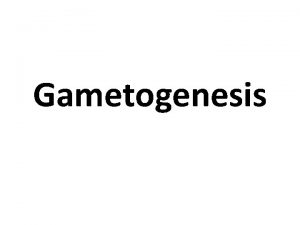Human Reproductive System Gametogenesis Occurs in the gonads

















- Slides: 17

Human Reproductive System

Gametogenesis • Occurs in the gonads (ovaries and testes) • Meiosis that results in the production of gametes (haploid) from germ cells (diploid cells) • Spermatogenesis and Oogenesis Slide 2 of 18

Oogenesis • Occurs in the ovaries— results in the production of 1 egg (and 3 polar bodies) • Begins when the female is an embryo—all primary oocytes form before birth and remain “frozen” in this stage indefinitely Slide 3 of 18

Oogenesis • Each month after puberty, one primary oocyte completes Meiosis I and begins Meiosis II • Meiosis II is completed only after fertilization occurs. Slide 4 of 18

Oogenesis • Characterized by unequal division of cytoplasm. • Why does it make sense for this to happen? – Allows for more nutrients to be available to the egg in case fertilization occurs. Slide 5 of 18

Spermatogenesis • Occurs in the testes in the seminiferous tubules— results in the production of 4 sperm • Mature in the epididymis and gain motility • Produced constantly after puberty Slide 6 of 18

Spermatogenesis • The midpiece contains lots of mitochondria —why? – The sperm have a long journey they need a lot of energy (hence the need for lots of mitochondria) Slide 7 of 18

Male Reproductive System • Testes – where spermatogenesis takes place • Epididymis – where sperm mature • When sperm leaves the body, it will go up the vas deferens, past the following glands: – Bulbourethral gland – Prostate gland – Seminal vesicles Slide 8 of 18

Male Reproductive System • Secretions of these 3 glands, contribute to the semen • Bulbourethral glands - produce an alkaline solution to neutralize acidity of urethra • Prostate gland – clotting enzyme to make semen gelatinous, solution to make environment in uterus more “friendly” • Seminal vesicles – solution that contains food (fructose) for the sperm. Slide 9 of 18

Pathway of Semen • Epididymis Vas Deferens Urethra • A vasectomy is a procedure in which the vas deferens is cut so that the man will no longer be able to father children. Slide 10 of 18

Female Reproductive System • Ovaries – where oogenesis takes place • Oviduct (Fallopian Tube) – where fertilization takes place • Uterus – where the embryo grows and develops • Vagina – birth canal Slide 12 of 18

Female Reproductive Hormones • See hormone chart in notes • Gn. RH released from hypothalamus causes the release of LH and FSH from the pituitary gland • LH and FSH act on the ovaries and cause them to produce estrogen and progesterone – Feedback mechanisms will be discussed in the next few slides Image taken without permission from http: //bcs. whfreeman. com/thelifewire/ Slide 13 of 18

Female Menstrual Cycle • Each month, a woman’s body prepares for the possible fertilization of an egg • Ovarian Cycle = an egg matures (from a primary oocyte) and is released • Uterine Cycle = the endometrium (lining) of the uterus builds up (becomes ready to have a fertilized egg implant) then breaks down (if no fertilization occurs). Slide 14 of 18

Female Menstrual Cycle • An oocyte & the cells around it = follicle • Usually, only one follicle fully matures during each ovarian cycle • Ovulation – release of egg from ovary triggered by a surge of LH. Slide 15 of 18

Female Menstrual Cycle • The corpus luteum is the remaining cells of the follicle – Continues to produce estrogen and progesterone for approximately 2 weeks maintains the thickness of the endometrium – If no fertilization occurs, it degenerates endometrium is no longer maintained. – This starts the whole cycle over again. Slide 16 of 18

Female Menstrual Cycle • Day 1 = first day of a woman’s period • Hormonal control is complicated! – During different times of the cycle, Estrogen can either stimulate or inhibit other hormones Image taken without permission from http: //bcs. whfreeman. com/thelifewire/ Slide 17 of 18

Female Menstrual Cycle • If fertilization occurs, the embryo secretes HCG which maintains the corpus luteum – Eventually cells derived from embryo will secrete estrogen and progesterone to take over for the corpus luteum – h. CG is what is tested for in pregnancy tests • Birth control pills are synthetic progesterone and estrogen that “trick” the body into thinking the woman is pregnant – no ovulation occurs Slide 18 of 18
 Plants reproductive system
Plants reproductive system Note on hypothalamus
Note on hypothalamus Human reproductive system
Human reproductive system What are gonads
What are gonads External anatomy of a squid
External anatomy of a squid What ate gonads
What ate gonads What is gonad
What is gonad Lymphatic drainage of vulva diagram
Lymphatic drainage of vulva diagram Gonads
Gonads Monads and gonads
Monads and gonads Endocrine molecules
Endocrine molecules Chromaffin cells
Chromaffin cells Gonads
Gonads Define gametogenesis
Define gametogenesis Starfish dissection
Starfish dissection Ducts in female reproductive system
Ducts in female reproductive system Endocrine system and reproductive system
Endocrine system and reproductive system Caracteristicas de la meiosis
Caracteristicas de la meiosis

